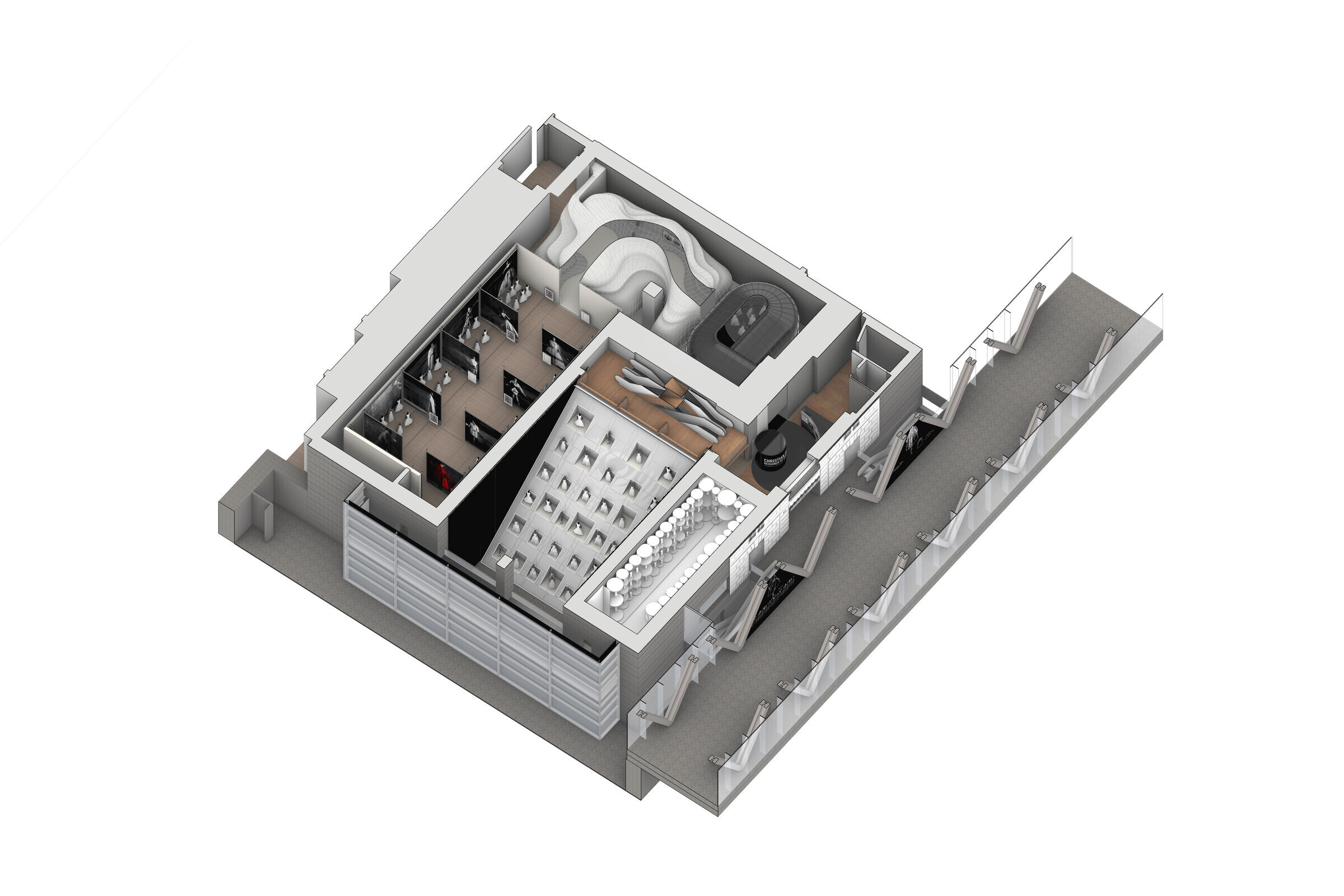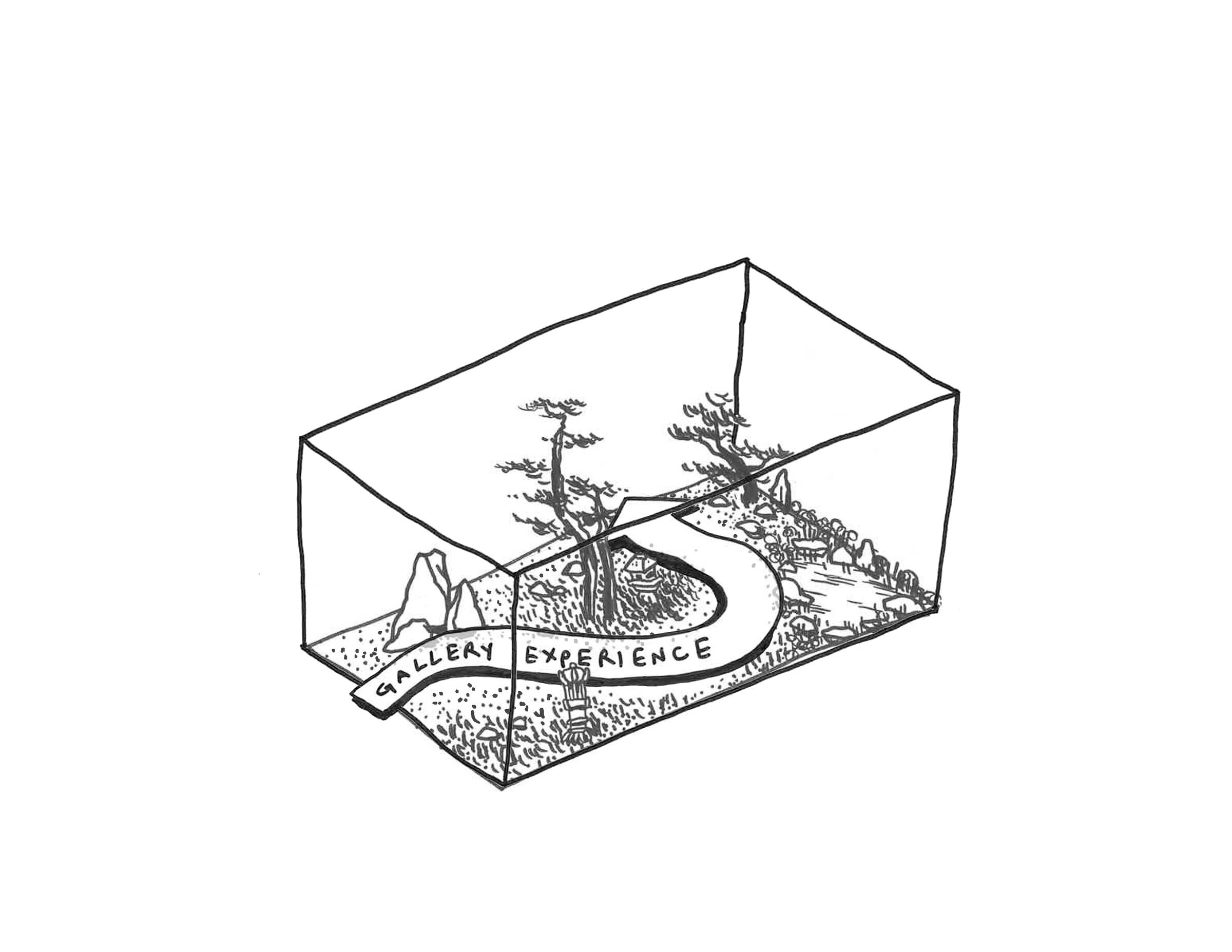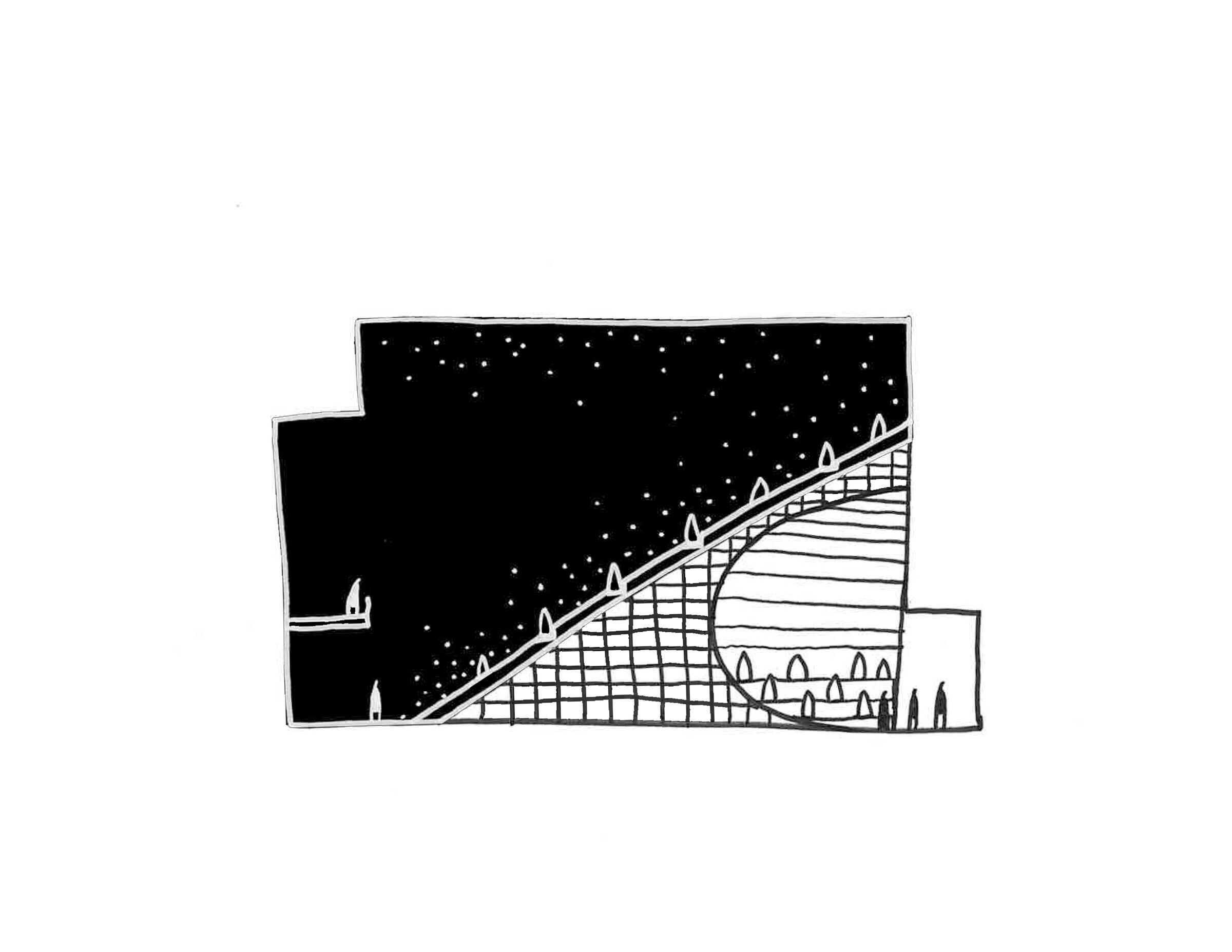The House of Dior is built upon Christian Dior’s spirit of reinvention and global reach in fashion, a legacy that simultaneously persists and evolves with the contributions of individual creative directors. The scenography for Dior: From Paris to the World at the Denver Art Museum and Dallas Art Museum defined continuous narrative journeys—in each, a seamless path and unified backdrop for garments and artworks that reflected over 70 years of The House of Dior.
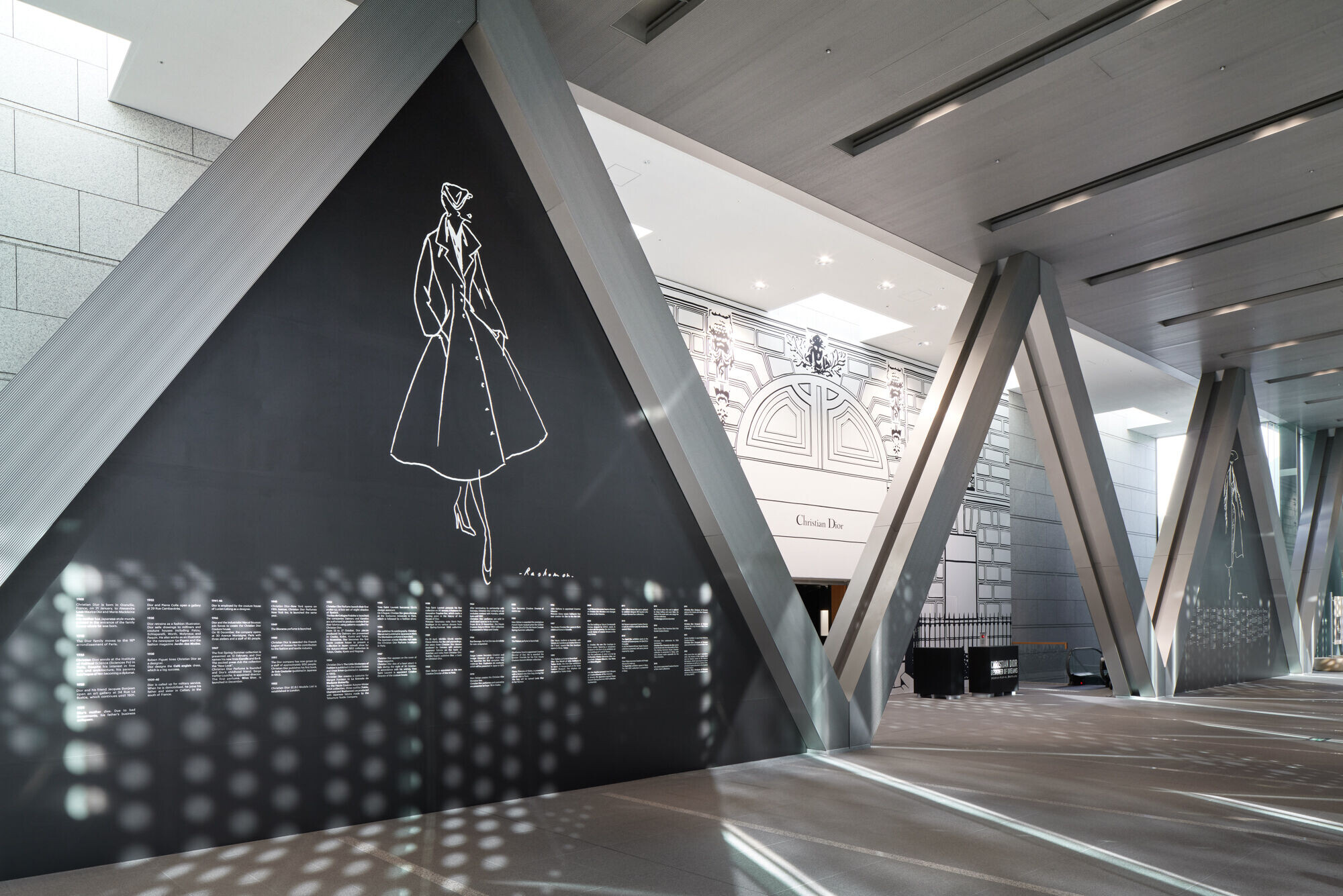
In Japan, a country of both technological innovation but also a rich, traditional culture, the exhibition design for Christian Dior: Designer of Dreams reflects a diverse multiplicity within historic and contemporary contexts simultaneously. The scenography reimagines the white-cube gallery beyond its limits to provide an immersive and varied experience more akin to set design with rooms transitioning between light and dark, intimate and grand, organic and orthogonal.
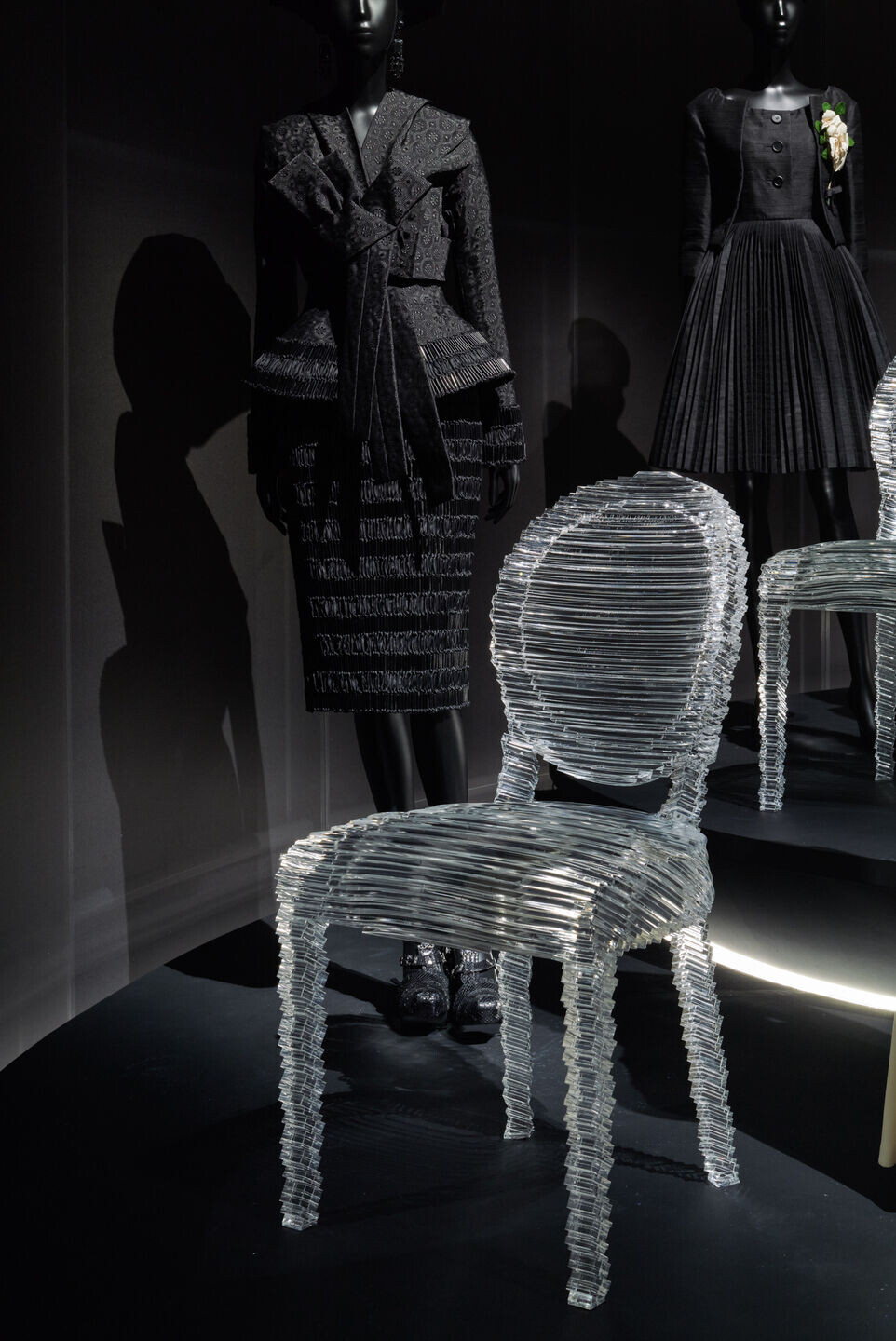
Across two floors of the MOT, 22 curatorial themes are deployed into separate, specific, immersive environments. The set designs utilize different techniques, materials, or motifs referential to elements shared between Japanese tradition and culture and Dior history and contemporary collections. Visual and spatial qualities of known elements and construction techniques like Shoji screens and Nebuta1 floats are manipulated, exaggerated, and shaped into contemporary forms. Familiar and enigmatic, the constructed landscapes create a series of distinct and immersive environments and a new set of surfaces to expand storytelling capacity.
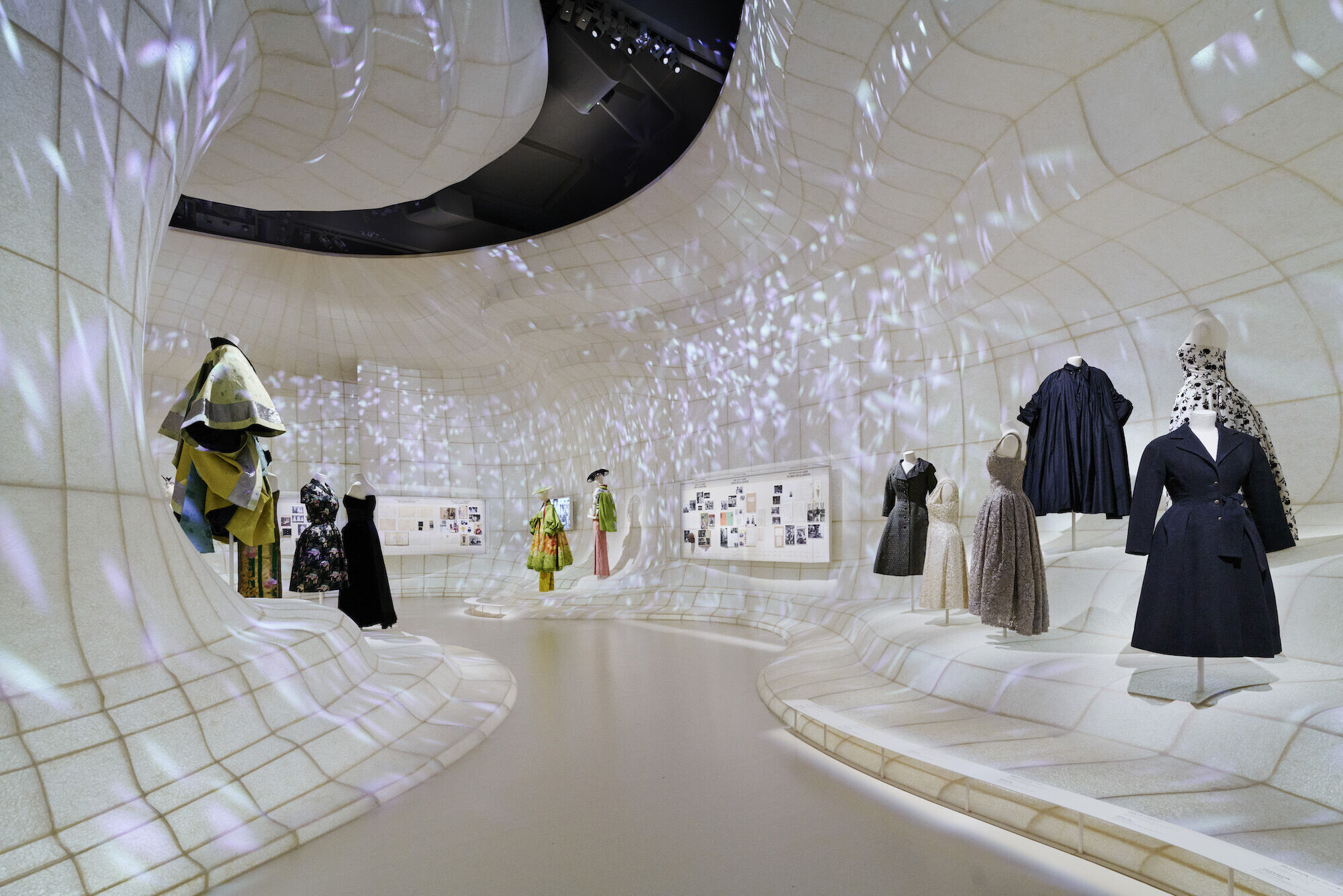
In one of the key themes of the exhibition, “Dior and Japan”, a winding path and pockets for display along it, akin to stations of the Japanese Tea Garden, is expanded vertically and horizontally. The wooden structure is wrapped in backlit Tenjiku fabric and Awagami washi paper, creating a layered, luminous backdrop for the garments and artifacts. The three-dimensional landscape is projected onto with various patterns and motifs to further activate the space.
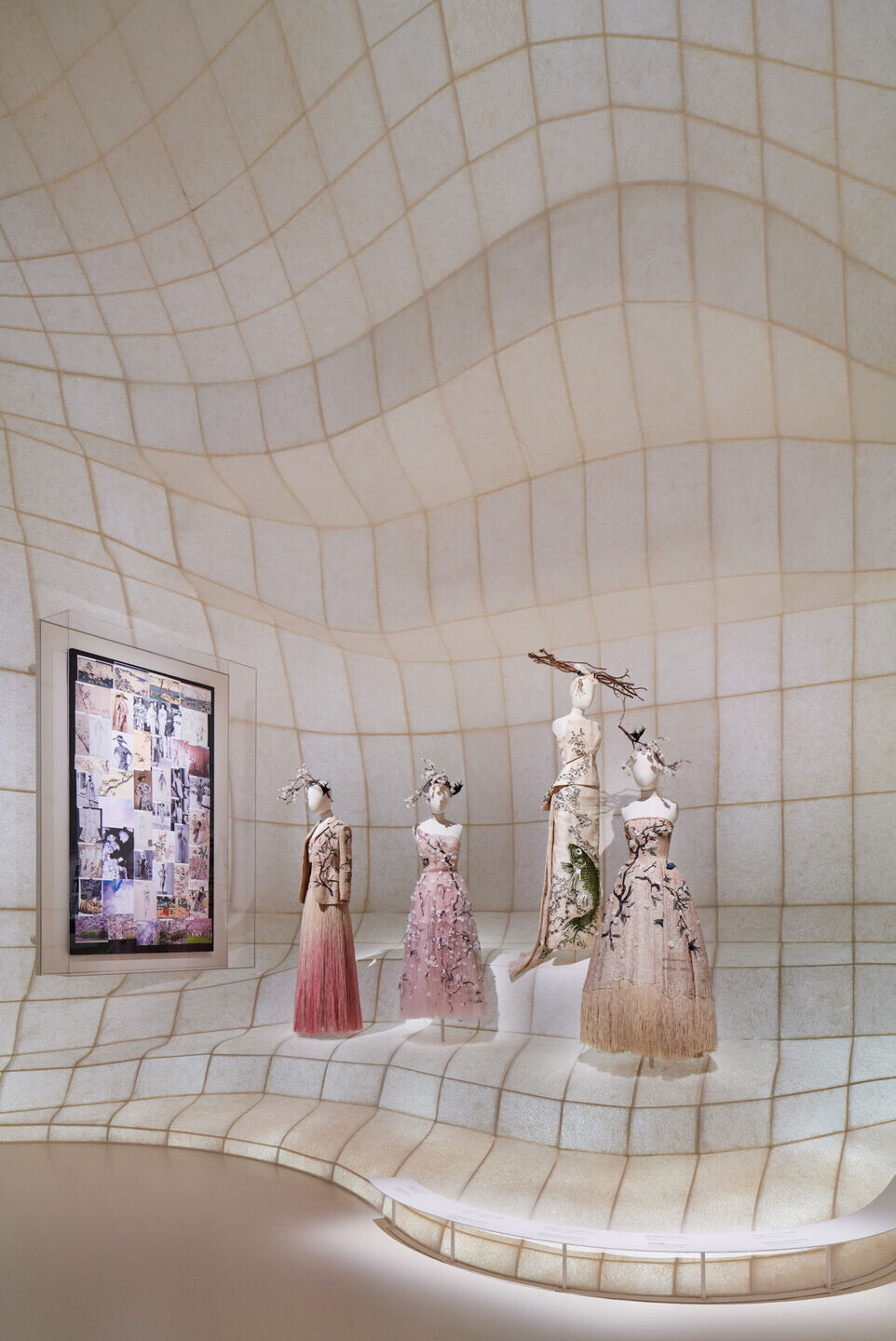
“The Dior Legacy” is a unified framework of a series of spaces dedicated to the House of Dior’s seven creative directors. Enlarged fabric panels are deployed as enfilade dividers that draw from fusuma2 and Sudare3 hanging panels commonly used in Japanese interiors to organize multiple environments in a single space. The screens used to segment the space are printed with larger-than-life photographs by Yuriko Takagi, creating an additional narrative medium that provides a visual understanding of the continuity from one creative director to another.
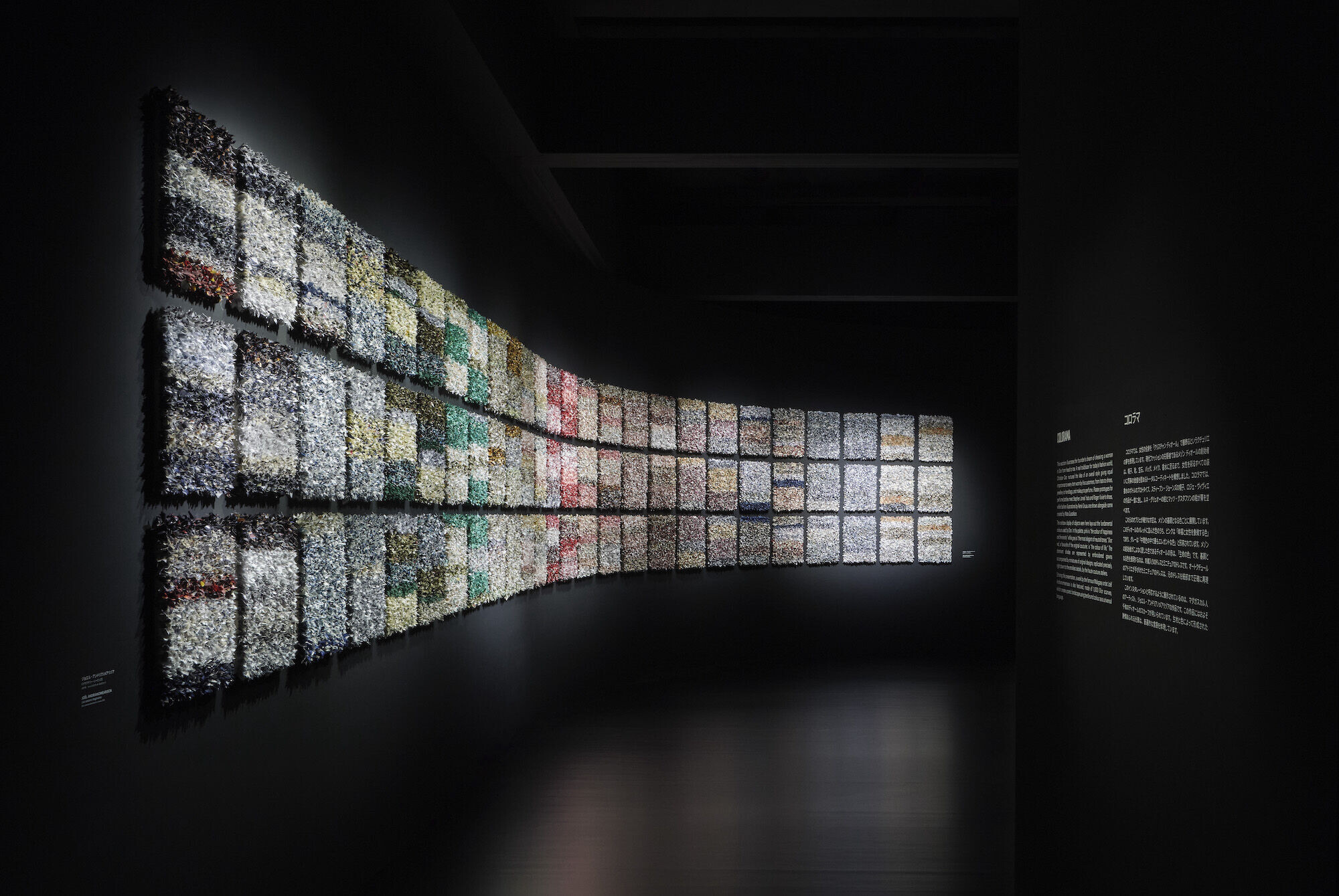
The “floor” of the museum atrium is lifted and sloped to bisect the lofted space diagonally, creating a double-sided display. The top becomes a single, grand slope for “The Dior Ball”, the grandest set of the exhibition, where mannequins in gowns climb up as spectators view their “procession” from below or above from a bridge. An angled mirror at the top of the slope continues the geometry infinitely and reflects the garments and scenography in an unexpected way. A more intimate environment is inserted underneath for “Dior around the World.” Visitors step into a domed room comprised of layers of concentric fabric surfaces, forming a scenographic hemisphere with animated projections.
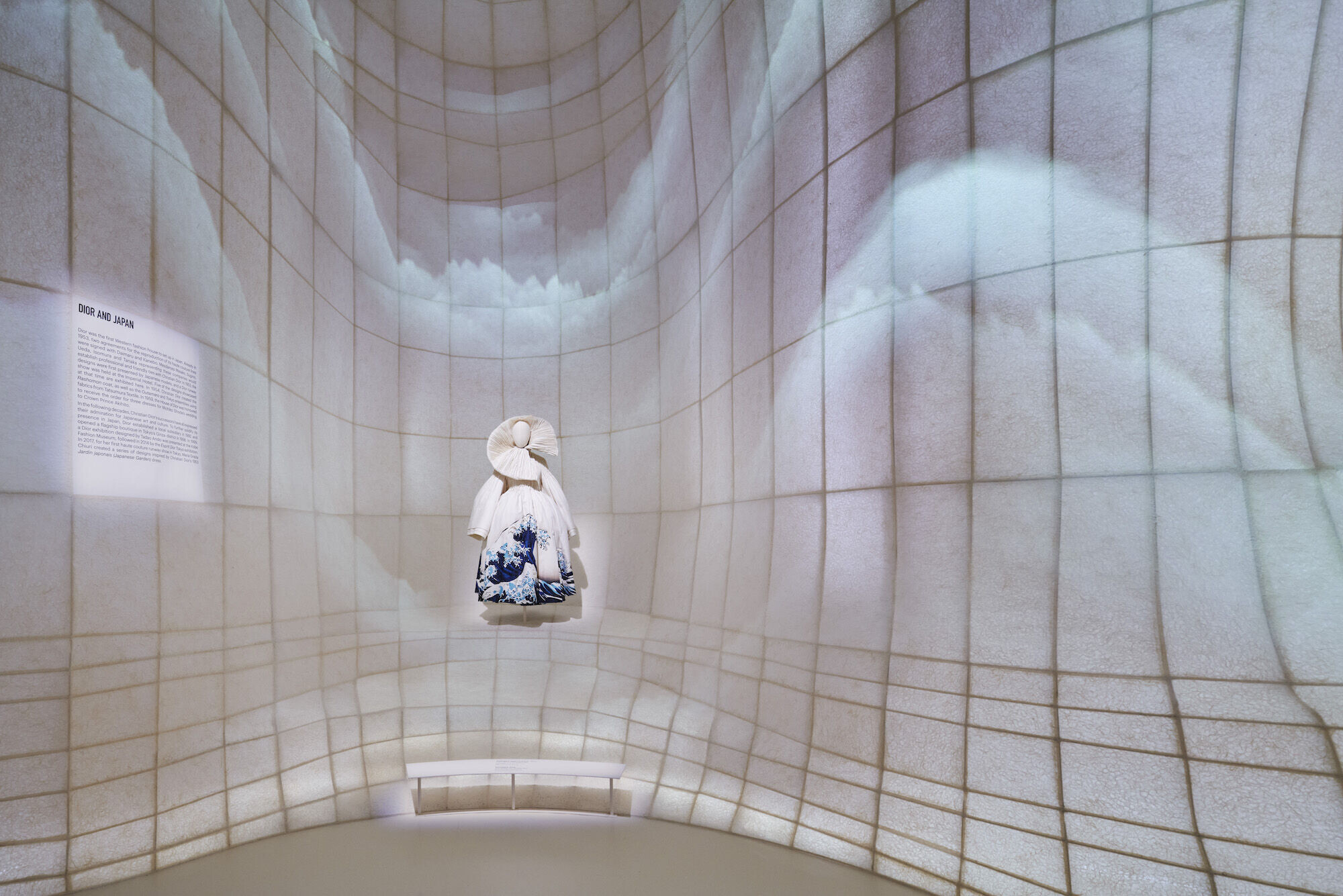
Together with nine other rooms, a sequence of themes and distinct environments comprise a diverse exhibition scenography. The rooms collectively take visitors through a journey of discovery through the history of the House of Dior, revealing the multifaceted relationship between the House and Japan against contemporary juxtapositions.
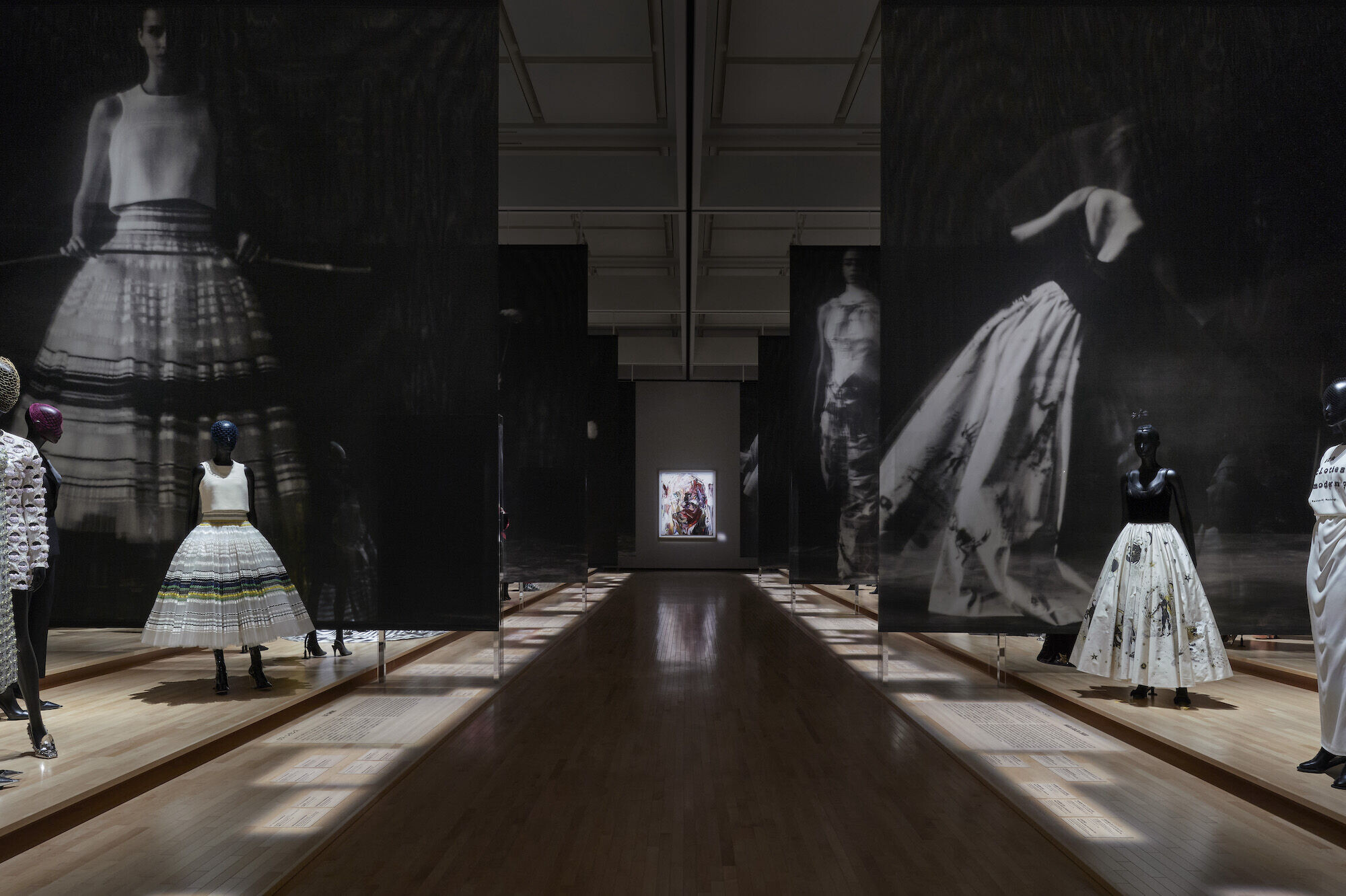
0. ENTRY THRESHOLD – TIMELINE
A timeline tracing the history of the House of Dior is accompanied by Dior’s sketches from his Japan Collection
- Display of the timeline and sketches is integrated into the existing structural truss/architecture of the museum
- In previous exhibitions, timelines were displayed inside the gallery, available only to ticket holders. Here, the timeline is an active threshold between the museum and the gallery open to the general museum visitor
- Visitors can view and learn about Dior in Japan without entering the exhibition itself
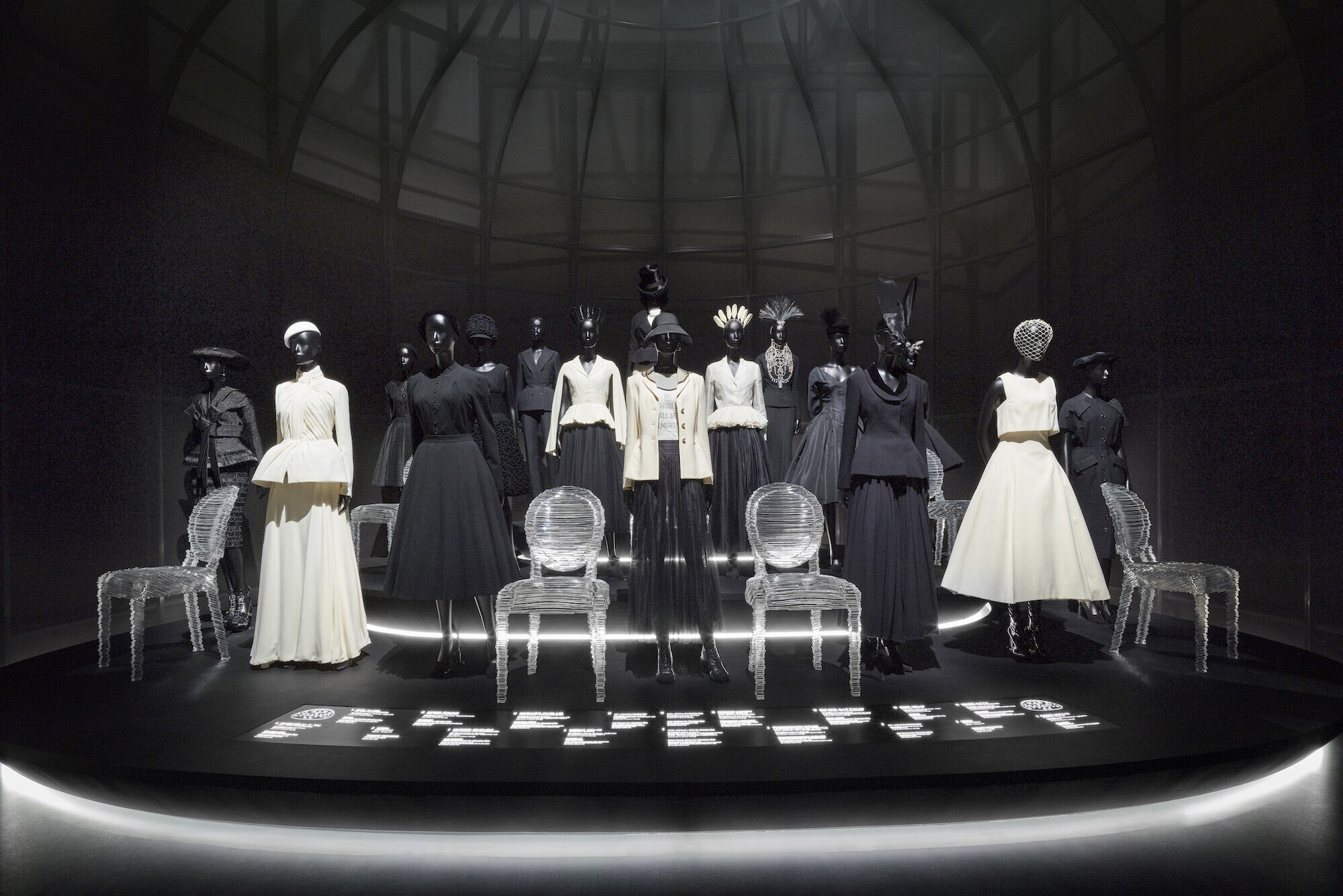
1. CHRISTIAN DIOR, FROM ART TO FASHION
Christian Dior’s gallerist beginnings and the significant artworks from before his foray into the world of fashion
- A convex marquee and concave wall define a clear beginning to the exhibition, with physical and graphic curves to draw people in
- On the concave wall is Man Ray’s photograph of Surrealist Exhibition at Pierre Colle Gallery in Paris (1933), with objects by Salvador Dali, Marcel Duchamp, Max Ernst, Man Ray, and Yves Tanguy
- A single vitrine is integrated into the curved wall to display the Man Ray object
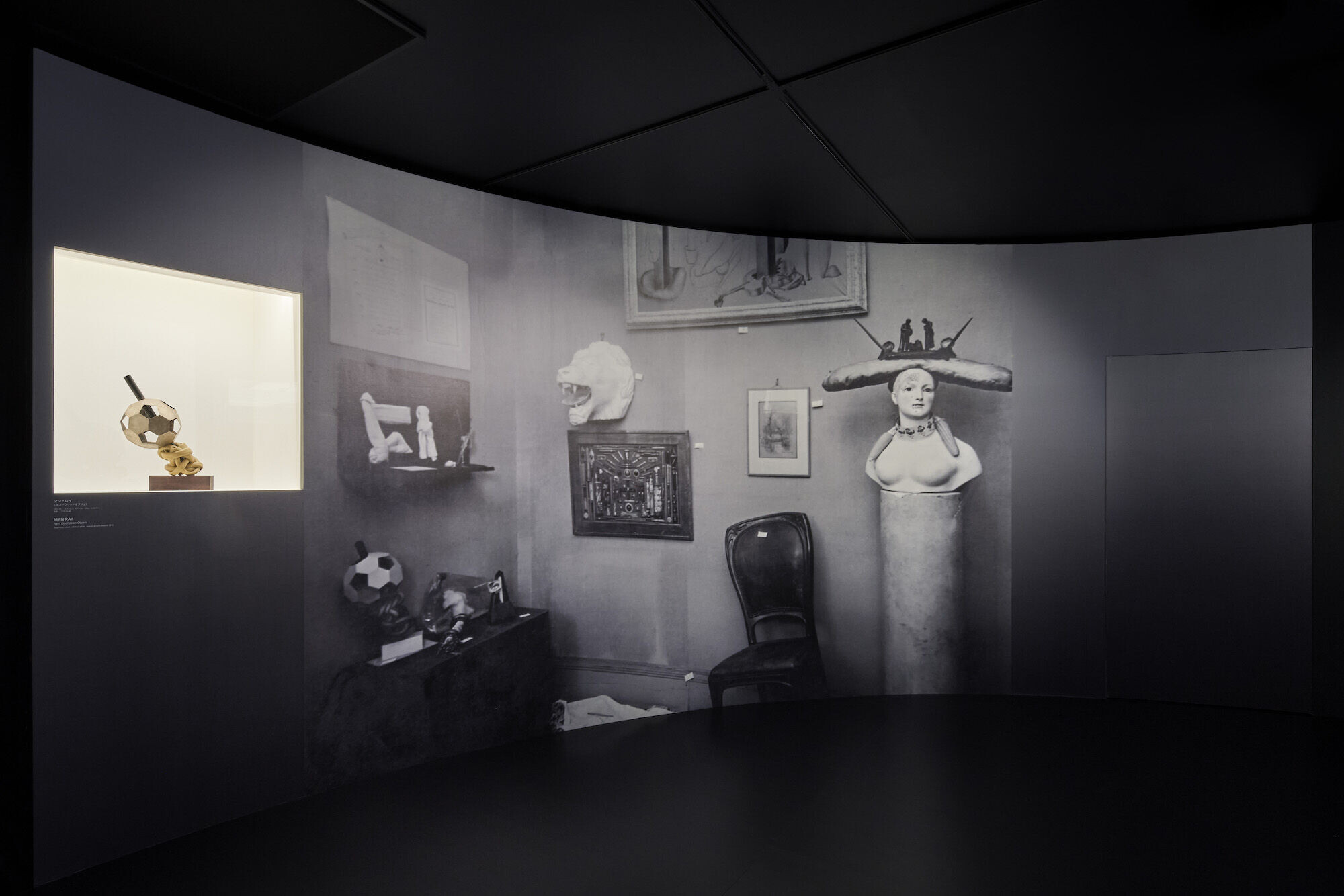
2. THE NEW LOOK
“The New Look” presents the Bar Silhouette invented by Christian Dior and its iterations and interpretations by the House of Dior’s various creative directors over time
- Drawing from the strong, feminine curvature of the classic Bar Jacket form, the scenography structure creates a continuous, curved surface enveloping the room in the same silhouette
- A translucent fabric stretched over the expressive frame exposes the structure, embodying and revealing the structure behind the garment
- The fabric is printed with a black to white gradient to visually draw attention to the form
- The monochrome gradient, when applied to the curved form, emphasizes the gradual curve
- Black and white was chosen as a neutral but resonant shade to the typically black and white New Look garments
- A single vitrine at the center highlights Dior’s Bar Jacket and anchors the space
- Artworks are wall-mounted through the fabric, to appear as if they are suspended
- Floors are black vinyl
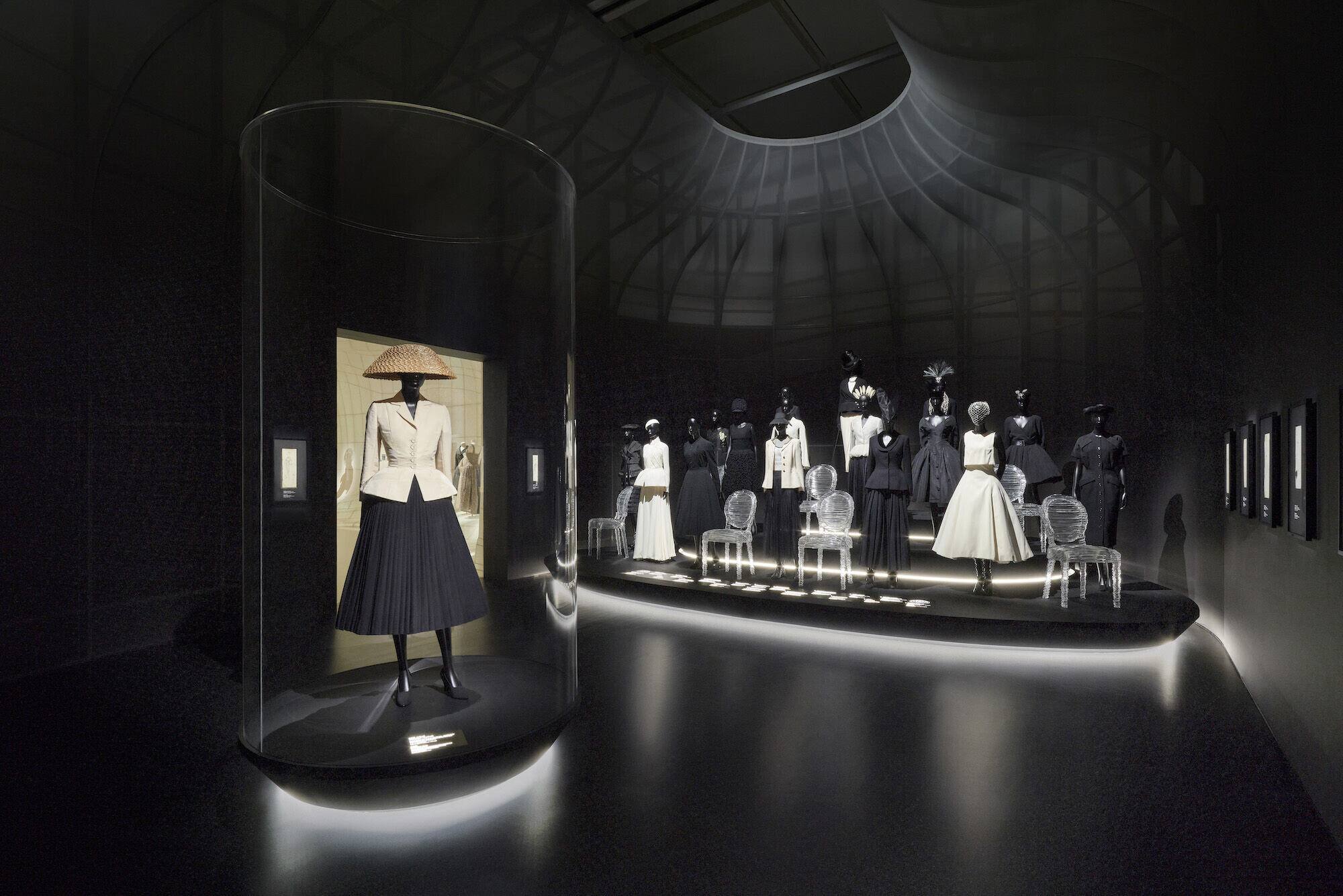
3. DIOR AND JAPAN
An in-depth exploration of the many ties between Dior and Japan, including never-before-seen archival documents recounting the relationship between Christian Dior—from Dior’s first collections to travel to Japan and partnerships with Daimaru and Kanebo, to fabrics, patterns, and silhouettes of Japanese traditions adopted and inspired Christian Dior and subsequent creative directors. “Dior and Japan” takes visitors on a winding garden path defined by stations of the Japanese Tea Garden Sequence, enveloped by a constructed landscape reminiscent of techniques used in traditional Japanese Nebuta paper floats as well as the armatures used to create Dior’s more structural garments. The resulting three-dimensional landscape becomes an organic surface for projecting abstracted imagery.
- 5 garment groupings
- The scenography is designed for surprising discoveries, reflecting Dior Archive’s own recent discovery of a historical documents while researching the house’s footsteps in Japan
- The set design draws from the winding paths of Japanese gardens, traditional Nebuta floats with figurative forms and depictions of stories, and the boning used in the construction of Dior garments
- The 5 garment groupings are organized in 5 distinct clusters at varying heights (alternating from high-medium-low) along a winding path
- A traditional Awagami washi paper from Tokushima prefecture made of linen fabric is applied to a wood structure takes on a contemporary form by extruding the organic path vertically to immerse visitors in an environment that feels familiar in materiality but contemporary in shape
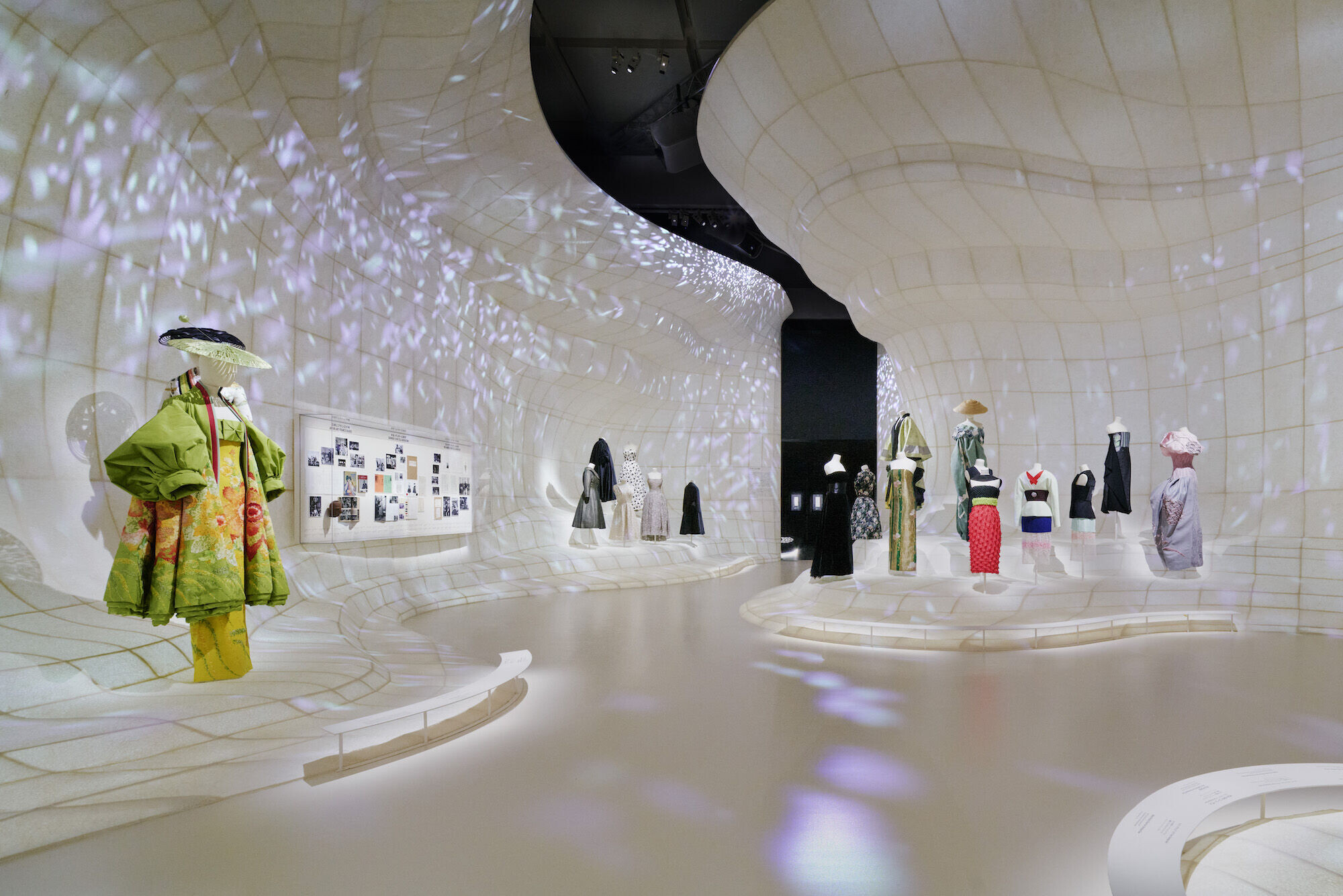
4. THE DIOR LEGACY
The House of Dior represents a force in fashion, from history to modernity, that continues to influence many facets of culture and blurs the boundaries between art, fashion, and architecture. This force is established and maintained by the unique vision of the individual creative directors who have contributed to a consistent creative language and legacy of the House over time. The scenography for “The Dior Legacy” aims to create an environment that acknowledges and brings attention to the individuality of creative directors, while simultaneously demonstrating a continuous and consistent narrative.
- An enfilade gallery of a series of spaces within a unified framework takes visitors through individual areas dedicated to the 7 creative directors, while maintaining a connected view and flow from one to another
- Hanging fabric panels create enfilade dividers that draw from fusuma and Sudare commonly used in traditional Japanese spaces to organize multiple environments in a single space
- 3’ low platforms made of wood matching the museum’s existing floors emphasize the scale and verticality of the hanging screens
- The panels provide additional backdrops for display—made of thicker-weaved scrim, with photography by Yuriko Takagi printed directly onto them
- By layering Takagi’s photographs, screens intended to divide also offer an additional narrative medium, providing a visual understanding of the continuity from one creative director to another

5. YURIKO TAKAGI
Yuriko Takagi’s esteem for and careful consideration of shadow is an extension of her photographic practice and career-long contemplation of natural light—a theme that plays a pivotal role in her work for this exhibition. Takagi’s photographic work spans three spaces: “The Dior Legacy”, and over two-levels: a bridge over-looking “The Dior Ball” and on the basement level in the same room as and facing “The Dior Ball.”
- The location on a narrow bridge overlooking “The Dior Ball”, the space is a preview and intimate experience ahead of the grand moment to come below
- The bridge-level displays Takagi’s smaller photographs to resonate with the scale of “The Dior Ball” garments in view from the distance, while the basement-level display’s Takagi’s large-scale photographs to resonate with the human-scale of “The Dior Ball” garments directly across
- Like Takagi’s considerations of garments in movement and light, the display wall is designed to define moments of pause as visitors walk from photo to photo through form and “color”
- A variegated wall expressed to follow the exhibition path creates a folded plane reminiscent of pleating techniques used in many Dior garments
- The wide side of each pleat becomes a display surface for a single photograph (A2; 420 x 594 mm)
- Drawing from the inherent movement and black and white shades of Takagi’s photography, the dégradé (gradient) wall transitions from black to white, further emphasizing the directionality defined by the pleated wall
- The transitional display leads to the all-white room of “The Dior Ateliers”

6. THE DIOR ATELIERS & HAUTE COUTURE AND READY-TO-WEAR
“The Dior Ateliers” is a theme that has been consistently shown in all Dior exhibitions across the exhibition’s various venues around the world. The theme captures Dior’s garment-making process of translating sketches into physical form by constructing toiles, simple white muslin fabric mock-ups that define lines and volumes of couture garments before they are made with final fabrics.
- The dense walls of display present objects in a shelving system fit to the venue’s spatial conditions
- For the first time, “The Dior Ateliers” is displayed on circular shelves rather than the traditionally orthogonal ones used in previous exhibitions, this liberates displayed objects from a boxed-in configuration and maximize views to them from multiple directions
- The circle focuses attention to each individual garment or object
- 10 objects mechanically rotate, further expanding vantage point possibilities
- A virtual layer is added to the otherwise monochromatic room and garments, with visuals of Dior handiwork and techniques projection mapped onto the white, toile surfaces of 8 garments
- A mirrored ceiling transforms the gallery into an infinite room of object density as it reflects garments, exhibition armature, and visitors simultaneously
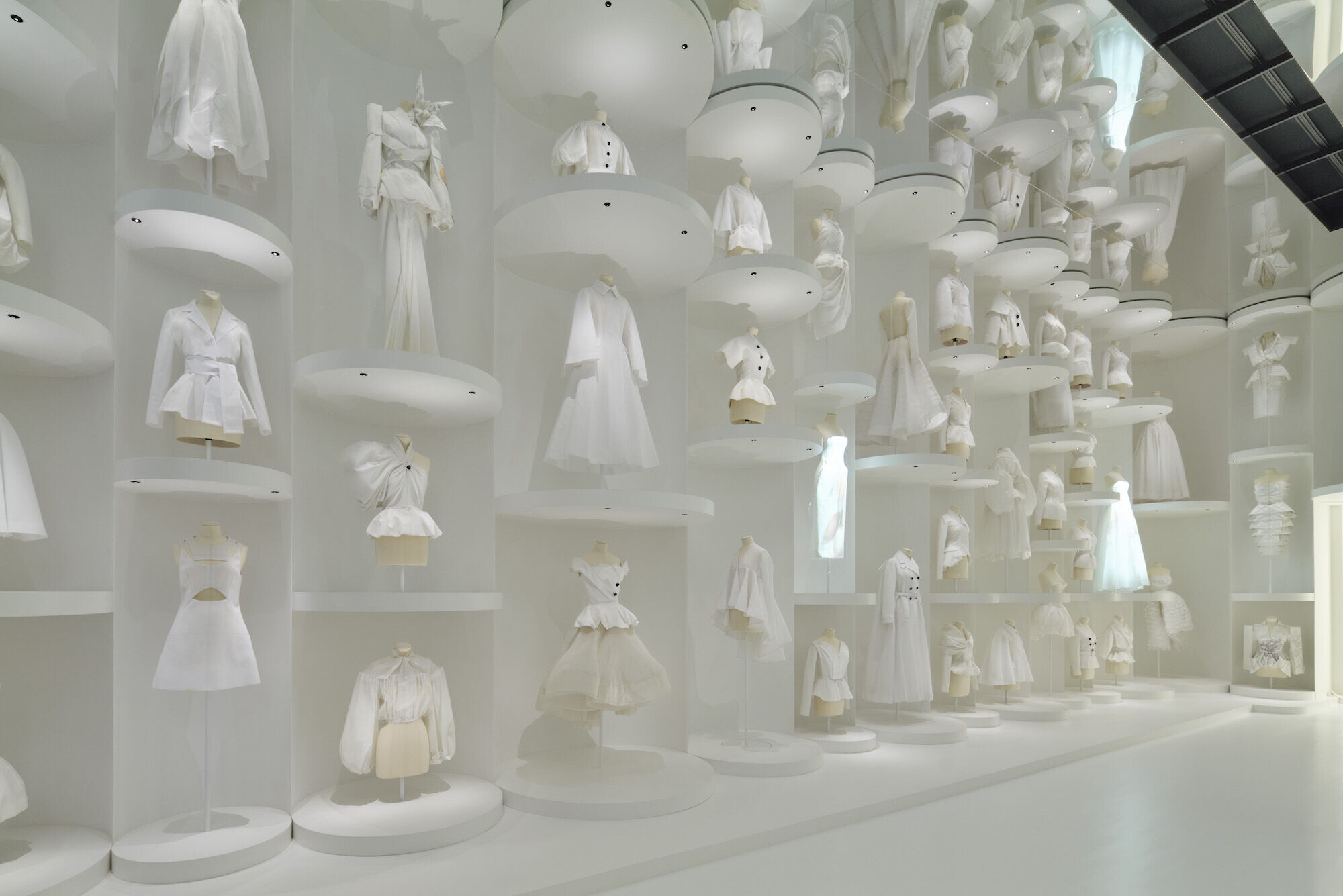
7. PROJECTION ROOM
As the first room visitors will enter on the lower level, and approximately halfway through the exhibition, the projection room provides a moment of respite within the large, content-rich show. The room features a variety of magazines that have showcased Dior garments over the years, and a video of Dior runway shows.
- The Projection Room is an intimate beginning to the series of rooms on the basement level
- The walls are covered with a new interpretation of Dior’s traditional Toile de Jouy fabric
- A dark blue velvet printed with the Toile de Jouy is mounted over all wall surfaces and custom-made benches, with a vinyl flooring of the same print

8. COLORAMA
Dior rejected boundaries between elements of clothing and constituted elegance into a complete “look” reflecting the aesthetic concept of Gesamtkunstwerk, or “total work of art”. Coloroma highlights the variety of accessories, fragrances, cosmetics that the House of Dior produces, in addition to garments, organized chromatically. A large-scale artwork by artist Joel Andrianomearisoa, made of upcycled Dior scarves, is displayed opposite the Dior artifacts and garments. The slight curvature of the walls draws visitors into the space, leading directly to the adjacent theme.
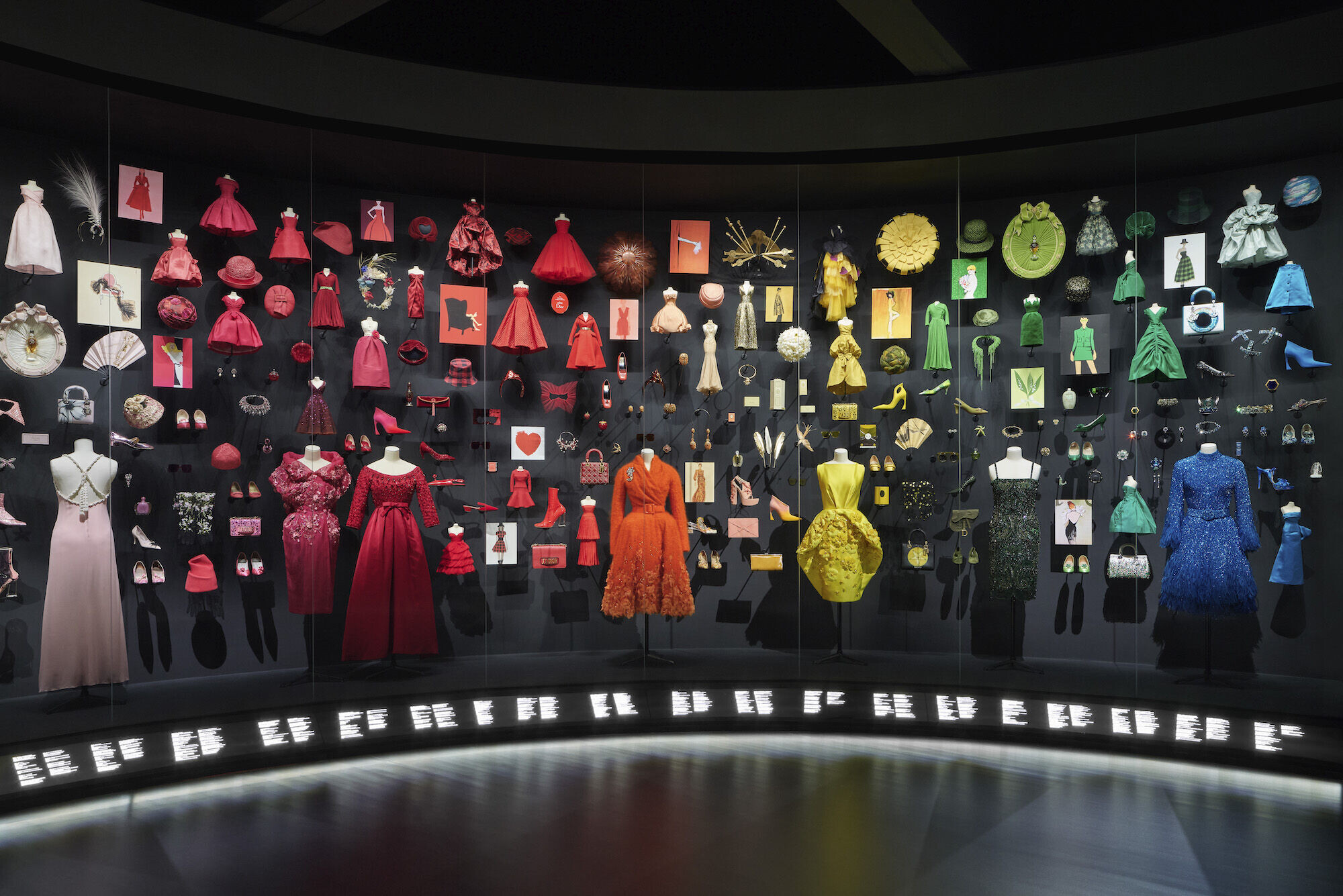
9. MISS DIOR’S GARDEN
Dior’s first collection was titled “Corolle”, named for the circle of petals at the center of the flower, while nature and flowers were a consistent reference throughout both Dior’s and subsequent creative director’s collections. The garments and fragrances of Miss Dior evoke the first scent Dior created with perfumier Paul Vacher in 1947, while also paying homage to Dior’s sister, Catherine Dior, who was a French resistance fighter. A vitrine featuring archival documents and artworks relevant to Miss Dior provides additional historical background.
- Drawing from Christian Dior’s family villa in Granville, a wooden garden path raised 8-inches winds visitors through the house’s garden-inspired garments displayed on a reflective surface evoking water
- 5 garments rest on raised, circular platforms act as focal points along the garden journey
- The room draws from Japan’s vibrant spring festivals like the Fuji no Hana Festival and its impressive wisteria flower trellis structures and tunnels
- Japanese Kiri-e artist Ayumi Shibata’s paper flowers of Japanese varieties hang from the gallery ceiling
- The ceiling artwork fills the vertical space while the mirrored floor reflects it and the garments to create an infinite garden of wonder, immersing visitors in the ephemeral floral grotto
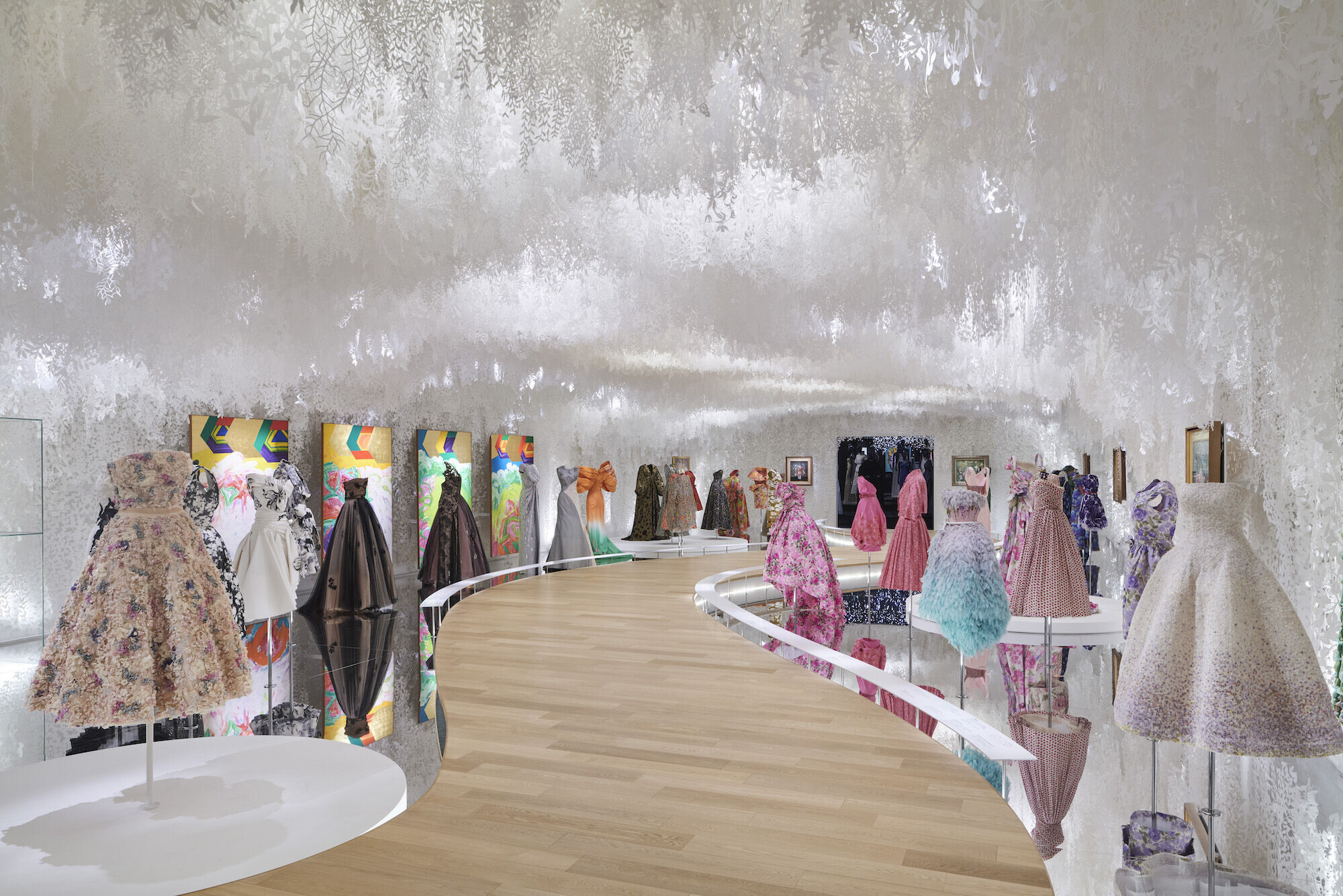
10. STARS IN DIOR & J’ADORE
“Stars in Dior & J’Adore” highlights just a few of the famous celebrities and women who have worn Dior garments over the years. Mannequins are placed on metallic circular platforms that have been etched with astrological maps and patterns, referencing the use of astrological motifs, charms, and talismans in the house’s collections. Gold metallic platforms feature specific J’Adore garments, and the use of gold in J’Adore perfume bottles. The scenography merges the two themes: Stars and J’Adore into one room, while a network of hanging LED lights and mirrored walls create an infinite celestial environment.
- A series of overlapping, circular platforms are inspired by Dior’s own penchant for astrological motifs and the subsequent use of celestial motifs in Dior collections, while also recalling the star mandalas of early Japanese Buddhist astrology
- The cluster of platforms is situated in the center of the room—it’s the only room of the exhibition in which visitors can freely walk around the garments and experience them from all angles
- Like the early celestial maps engraved in bronze discs, Dior garments worn by stars and celebrities are displayed on a series of black and gold discs with etching patterns drawn from historic eastern astrological charts
- The etched and painted discs subtly reflect the silhouettes of the garments on display
- 6 J’Adore Collection garments are displayed on gold discs
- 10 Stars in Dior garments are displayed on black discs
- 10 discs in 3 different sizes
- Suspended point LED lights create an artificial galaxy, and mirrored walls amplify the galaxy
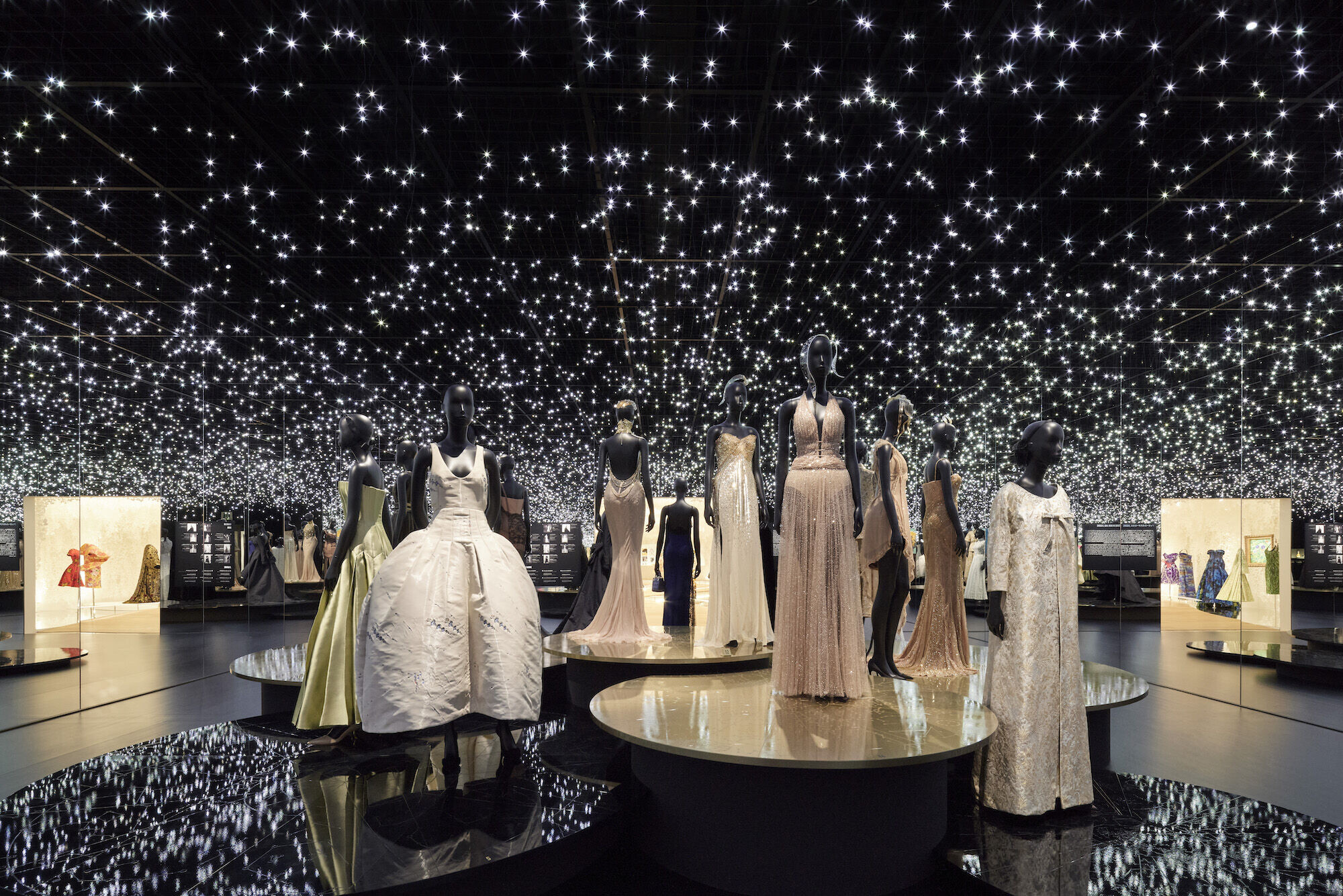
11. THE DIOR BALL
Dior couture garments are unique one-of-a-kind pieces, many of which are spectacular gowns of grand scale. Pairing the monumental scale of these garments with the space of the atrium, a single slope is extended the height of the atrium to highlight the grand nature of both garment and architecture. A mirrored screen placed at the top of the slope continues the slope infinitely beyond. The insertion of a slope into the atrium also provides a unique opportunity to feature two themes within the one space, one on the upper side, and one on the underside. The scenography for “The Dior Ball” offers unexpected perspectives and relationships to the garments on display that are simultaneously theatrical.
- “The Dior Ball” and “Dior Around the World” are displayed within the 19m (62.3 ft) tall B2F atrium of MOT, taking advantage of the atrium’s full, lofty height to showcase two themes in a single space
- The “floor” of the atrium is lifted and sloped to bisect the atrium diagonally, creating a double-sided display
- For the grandest set of the exhibition, “The Dior Ball” is displayed on the most theatrical “stair”
- The top of the diagonal infrastructure lifted from the atrium floor becomes an exaggerated, oversized stair for display reminiscent of the long, processional stairs up to the historic shrines of Japan
- Garments of “The Dior Ball” are displayed up the slope as spectators view the “procession” from above and below
- 4 different sizes of niche-openings and platforms within are dispersed across the 14,350mm x 14,950mm sloped surface
- A 45-degree angled mirror at the atrium ceiling “doubles” the gallery height
- An animation is projected onto the sloped surface for a dynamic display
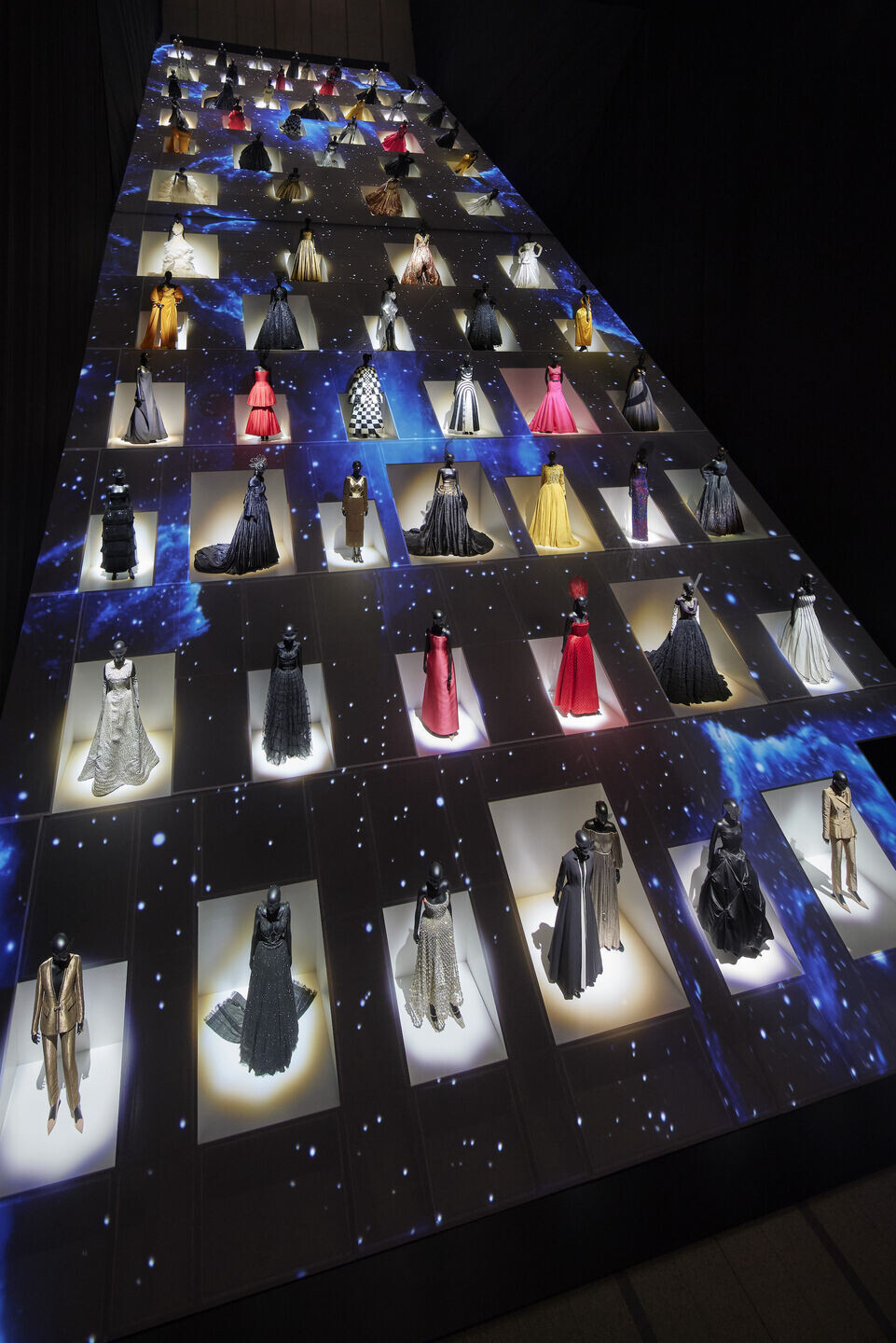
12. LADY DIOR
The Lady Dior bag was born and evolved in accordance with Dior’s adoption of the Gesamtkunswerk concept—a holistic design reflecting Dior’s identity. The Lady Dior bag has been established as a marriage of art and fashion and served as carte blanche for numerous artists who would develop limited-edition bags to transpose their own creativity into the Dior leatherwork language.
- To provide a setting for a series of treasured artifacts that have become a lasting symbol of the House of Dior, the room is designed as an endless cabinet of curiosities with a twist—completely surrounding visitors in an array of bags from commercial to sculptural
- An open shelving integrates individual shelving units, artwork, and text in a tight, irregular grid, flowing from floor to ceiling to create a seamless vault of Lady Dior bags
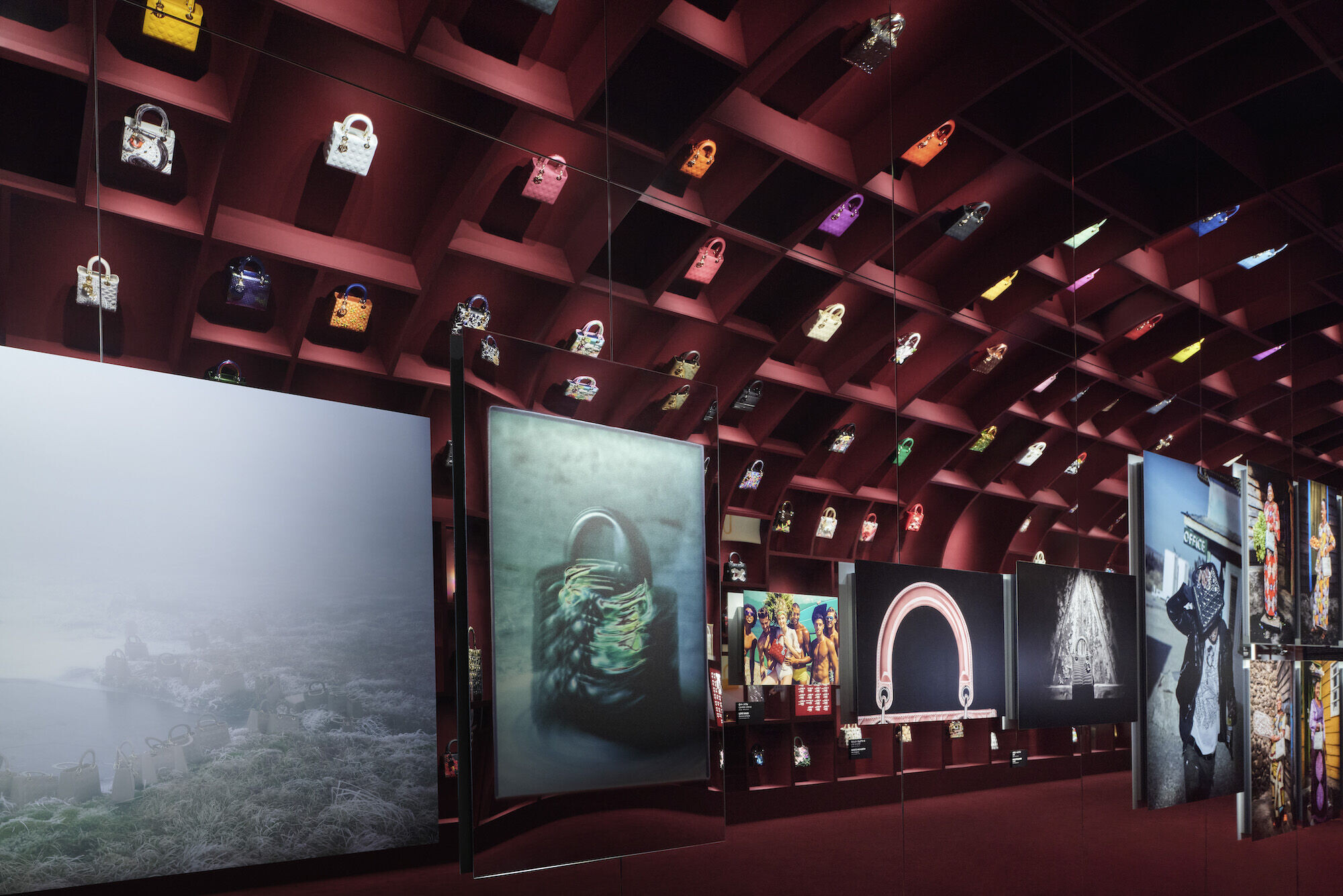
12. DIOR AROUND THE WORLD
The consistent theme that has carried on from one exhibition to another as it traveled across the world, “Dior Around the World” is a survey of more than 70 years of the House of Dior’s legacy and its global influence. It highlights how designs from the house have been inspired by different cultures across the globe.
- The same diagonal plane bisecting MOT’s atrium that serves as the exhibition surface for “The Dior Ball” creates a secondary space underneath it for “Dior Around the World”
- While “The Dior Ball” is an open spectacle that can be experienced even from a distance, “Dior Around the World” provides an intimate environment to fully immerse visitors in the display
- The infrastructure supporting the Ball is transformed into an armature used to integrate a domed room made of hanging panels of fabric so that visitors step inside the “hemisphere” of “Dior Around the World”
- The scenographic globe is composed of layered, concentric fabric backdrop spanning floor to ceiling
- The fabric layers that form the set environment provides an additional backdrop for projections
- Garments are clustered by region of influence—Greece, Africa, Egypt, Orient, Spain, India, China, Europe, and Japan
- Just outside of the hemisphere, is a field of 60 paper lanterns of 3 distinct sizes
- 45 Noguchi lanterns and 15 custom lanterns with prints of Dior fabrics and zoom-ins of select garments on display within Dior In the World
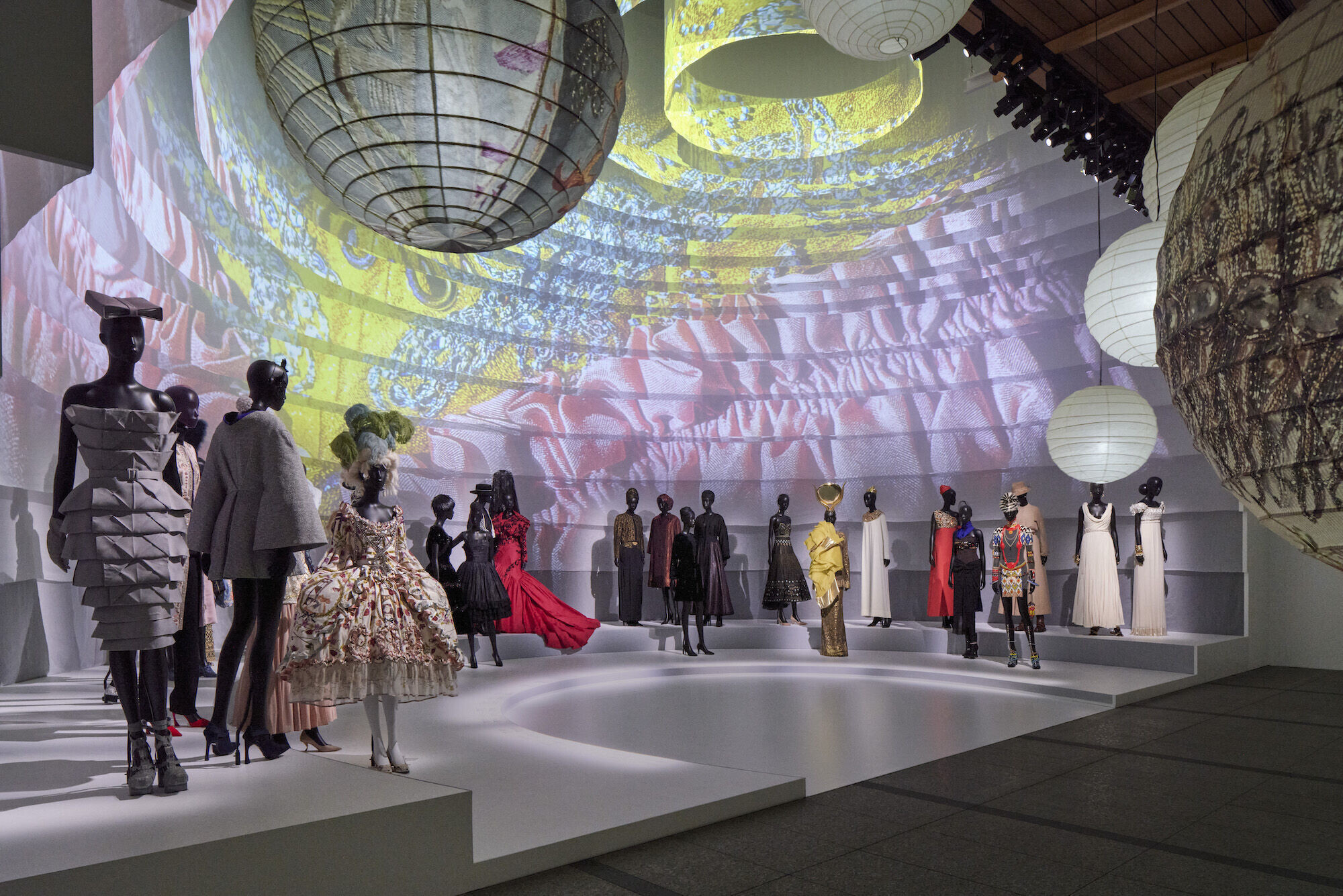
13. FINAL LOOK
The gold Avenue Montaigne dress transport visitors back to Dior in Paris–where after more than two years of renovation work, the House of Dior moved back into its historic home at 30 Avenue Montaigne, which now accommodates the boutique as well as La Galerie Dior, a museum space devoted to the couture house’s history. The Final Look, the last room of the exhibition is a contemporary end to the scenographic journey, highlighting a single key garment—the Avenue Montaigne dress—and artwork within a shibori-inspired blue gradient space.
- On display is a single garment, the gold Avenue Montaigne dress from Maria Grazia Chiuri’s autumn/winter 2019 Couture collection, in collaboration with British artist Penny Slinger
- A shibori indigo textile wall gradates from white to dark blue to white
- The gradual transition from white to dark blue simultaneously draws focus to and complements the singular golden garment in the room, while expressing the final exit
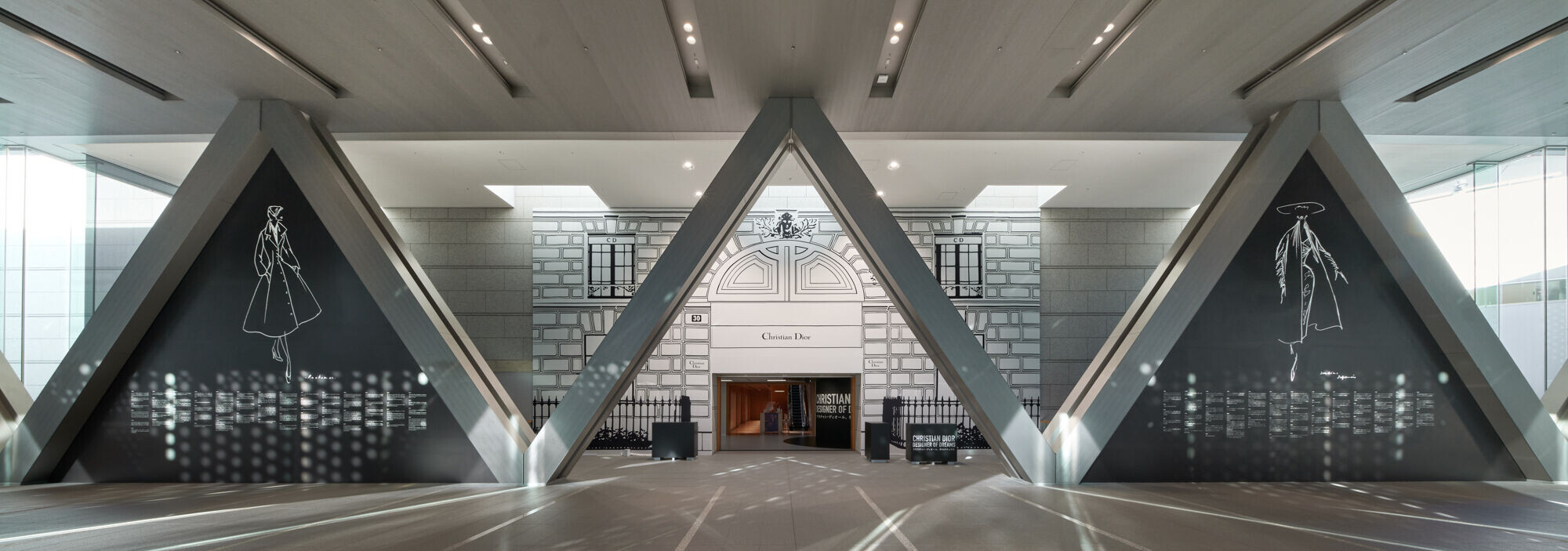
Team:
OMA New York
Partner: Shohei Shigematsu
Associate: Christy Cheng
Project Architect: Jesse Catalano
Team: Tim Ho, Jintong Duan, Janet Lu, Hangsoo Jeong, Byron Cai, Eugene Kim
Christian Dior Couture
Gérald Chevalier, Hélene Starkman, Daphné Catroux, Alice Gariepy, Alice Lefevre, Anne-Charlotte Mercier, Stéphanie Pélian, Charlotte Rezé, Isabelle Rousset
Curator
Florence Müller
Artists Featured
Kiri-e Artist: Ayumi Shibata
Photographer: Yuriko Takagi
Production
NPU Corporation: Noriyuki Asano, Tadahiro Konoe, Hisashi Shima, Mami Takezaki, Hidemitsu Sato, Przemek Sobocki
Mounting
Agence Alighieri: Noemi Bourgeois, Simon Jaffort
Construction
Branco Inc.: Hideki Furuya, Kengo Takagi, Kim Dong Woo, Kenji Nishihara
TSUMURA KOGEI Co. Ltd: Keiji Ueyama, Yasuharu Takekawa, Masahumi Kawazoe
Transportation and Installation
Yamato Transport Co., Ltd.
LP Art
Projections
NOLL Inc.: Takuro Kawashima, Hijiri Kato, Hiroto Kojima, Ikuya Takahashi, Shota Yamamoto, Kenjiro Yagi
TAKENAKA Co. Ltd: Masahiro Fumita, Taiki Nishikido, Yasushi Sera, Kotaro Takaie, Mamoru Sakagami
Lighting and Sound Design
HEART-S GROUP: Sousuke Tanaka, Masao Otomo, Tatsuaki Sakaguchi, Takefumi Baden, Yuri Kawakami, Nozomi Takebayashi, Akio Hasebe
Headpieces
Stephen Jones
Photography
Daici Ano
Image Courtesy
Dior
